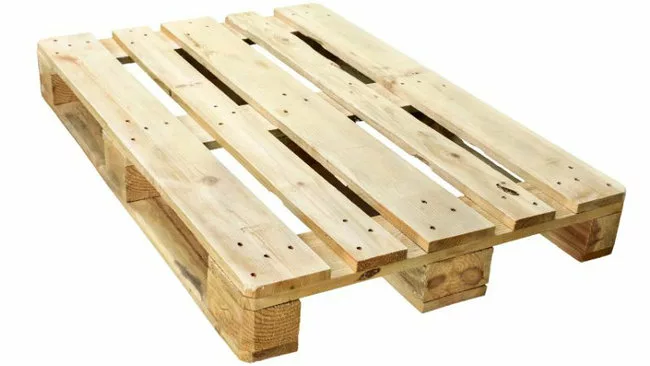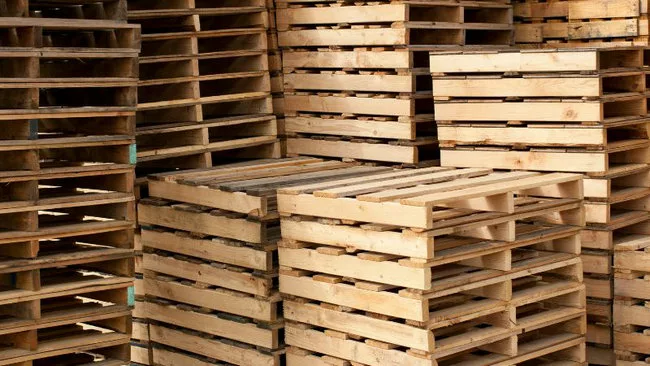
Overview of Standard Pallet Size
Concept of Standard Pallet Sizes
When it comes to handling and shipping goods, having a proper understanding of pallet sizes is essential. Standard pallet size is a widely accepted measurement that ensures uniformity across the industry.
Standardization of pallet sizes plays a crucial role in the global shipping and logistics industry. By maintaining a consistent size, it enables both shippers and receivers to:
- Effectively plan warehouse space
- Simplify the inventory management process
- Calculate shipping costs accurately
- Reduce damage to products during transportation
- Comply with international shipping regulations such as ISPM-15 (International Standards for Phytosanitary Measures No. 15), which aims to prevent the spread of wood-borne diseases and insects across international borders.
This increased efficiency reduces the overall cost of logistics and minimizes the environmental impact of unnecessary material usage and waste.
Efficiency in Shipping
Adhering to standard pallet sizes is crucial for optimizing space utilization during shipping. By utilizing standard sizes, you can:
- Maximize the number of pallets loaded onto a truck or shipping container
- Easily organize pallets in a warehouse or storage facility
- Allow for seamless movement of pallets with forklifts and other material-handling equipment
Using standardized pallet sizes ensures greater efficiency in shipping, warehousing, and overall logistic operations.
Physical Aspects of Pallets

Pallet Design
When considering pallet designs, it’s essential to understand the main components that make up a pallet. A standard pallet typically consists of deck boards like top deck, bottom deck, and stringers or blocks to provide structural support. The specific design depends on the type of materials used to manufacture the pallet, as well as the load requirements. This ensures that your cargo is safely transported and stored.
Pallet Dimensions
The dimensions of a pallet play a crucial role in determining its capacity to hold goods. In the United States, the most commonly used pallet size is the GMA standard, which measures 48 x 40 inches. However, several other standard pallet dimensions exist worldwide, such as 42 x 42 inches and 48 x 48 inches. To optimize space and efficiency in your supply chain, it’s important to consider the pallet sizes best suited to your products and regional specifications.
Weight Considerations
When using a pallet, it’s essential to pay attention to both its weight and the weight capacity it can support. A standard GMA pallet weighs around 37 lbs and has a weight capacity of up to 4,600 lbs, depending on the quality of materials used in its construction. Be aware of the weight of the goods you plan to transport and ensure that the chosen pallet can adequately bear the load to avoid potential damage or safety hazards during shipping and storage.
Pallet Protection
Protecting your pallets and their contents during transportation and storage is vital to minimize losses and maintain the integrity of your products. Some common methods of pallet protection include the use of stretch film, edge protectors, and slip sheets to reduce the risk of damage to both the pallet and your goods. Furthermore, it’s essential to adhere to best pallet stacking practices, which include evenly distributing weight and avoiding overloading pallets to ensure stability and prevent accidents.
Material of Pallets
Wood Pallets
Wood pallets are the most common type of pallets used in various industries. They are typically made from hardwood or softwood and come in various sizes. Wooden pallets can hold up to 4,600 lbs, sturdy and easily repairable. However, they can also be prone to moisture damage, splinters, and pests.
Plastic Pallets
Plastic pallets are an alternative to wooden pallets, offering some unique benefits. They are generally lighter and more durable than their wooden counterparts and are resistant to moisture, pests, and chemicals. Additionally, plastic pallets can be easily cleaned, making them a suitable option for industries with strict sanitation requirements. On the downside, plastic pallets are usually more expensive than wooden pallets, and due to their material, they may not hold as much weight as wooden ones.
Metal Pallets
Metal pallets, typically made from steel or aluminum, are another option for those looking for a more durable and long-lasting pallet solution. These pallets are strong, resistant to corrosion, and can handle heavier loads than wooden or plastic pallets. Metal pallets are also easy to clean and maintain, making them a preferred choice for industries with strict hygiene requirements or dealing with heavy machinery. However, they can be significantly more expensive and heavier than other types of pallets, which may limit their applications in certain industries.
Alongside the material, defining different pallet types is essential as it impacts how you transport the pallets and their loading capacity.
The sides of the pallets have wooden sections known as stringers. The stringer pallets, notable for their cost-effectiveness, feature notched stringer boards which enable the penetration and lifting of the forklift tines. These stringer pallets can have a 2-way entry (that permits loading from two sides) or a partial 4-way entry (allowing loading from all four sides with a forklift but only two sides with a pallet jack).
For heavier loads or when using forklifts, pallet jacks, or conveyors, it’s suggested to use block pallets. They offer more flexibility in handling since they can be lifted from any of the four sides – referred to as full 4-way entry pallets.
Standard Pallet Sizes Among Industries
Automotive Pallets
In the automotive industry, a common pallet size is the automotive half pallet, which measures 45″ x 48″. This type of pallet is designed to optimize the packing and transportation of automotive parts, reducing costs for manufacturers and suppliers. It is crucial for an automotive business to use these standardized pallets in order to operate efficiently and maintain compatibility with other businesses in the supply chain.
Retail Pallets
For the retail industry, the widely used pallet size is the 48″ x 40″ Grocery Manufacturers Association (GMA) pallet. This standard was set more than 40 years ago and accounts for approximately 30% of all wooden pallets produced each year. Retailers benefit from using this pallet size because it fits well within standard truck and shipping container dimensions, allowing for the efficient transport of products between suppliers, warehouses, and retail stores.
Military Pallets
The military has specific requirements when it comes to pallets. They use the 463L Master Pallet, which measures 108″ x 88″ and is made from aluminum, making it both durable and lightweight. This pallet size is designed for transporting large military cargo, such as vehicles, ammunition, and supplies. As such, it is critical that military pallets meet the necessary specifications to ensure the safe and secure handling of sensitive cargo.
Telecom Pallets
In the telecommunications industry, the most common pallet size is the 42″ x 42″ pallet. This pallet size suits the transportation of equipment like servers, switches, and other devices utilized in the telecom sector. By using a standardized pallet size, businesses in this industry can ensure their equipment is properly protected and packaged during shipping, reducing the risk of damage and associated costs.
Dairy Pallets
For the dairy industry, the pallet size may vary depending on the products being transported. However, one of the commonly used pallet sizes is the 40″ x 48″ specification. The dimensions of this pallet allow for efficient transport of dairy products, such as milk crates, cheese blocks, and other perishable items, ensuring that they reach their destination in a timely and safe manner.
Global Pallet Standards
North American Pallet Size
As we mentioned in the previous section, the Grocer’s Manufacturers Association (GMA) set the standard for pallets in North America, which became the basis for the American pallet industry. The most common size used in this region is 48 x 40 inches (1219 x 1016mm). Other frequently used dimensions include:
- 42 x 42 inches (1067 x 1067mm)
- 48 x 48 inches (1219 x 1219mm)
- 48 x 42 inches (1219 x 1067mm)
European Size Pallets
The European pallet is the standard pallet size in Europe with dimensions of 1200mm x 800mm (47.24″ x 31.50″). This pallet has become a symbol of European integration and cooperation. The EUR marking on the pallet indicates it meets the European standard.
Australian Size Pallets
In Australia, the most commonly used pallet size is 45.9 x 45.9 inches (1165 x 1165mm). This pallet standard meets the requirements of the Australian Pallets Association and ensures compatibility with most Australian companies’ equipment and infrastructure.
Asian Pallets
Various pallet sizes can be found across Asia, with the 42 x 42 inches (1067 x 1067mm) pallet being widely used in this continent. Other sizes may also be common depending on the specific country or region within Asia.
ISO standard
ISO( International Organization for Standardization) pallets are approved global pallet sizes that ensure compatibility between countries for international trade. There are six ISO-approved global pallet sizes:
- 48 x 40 inches (1219 x 1016mm) – most commonly used in North America
- 45.9 x 45.9 inches (1165 x 1165mm) – most commonly used in Australia
- 42 x 42 inches (1067 x 1067mm) – widely used across North America, Asia, and Europe
- 1200mm x 800mm (47.24″ x 31.50″) – most commonly used in Europe (Eur pallet)
These pallet standards, including GMA Pallet, Euro Pallet, and ISO pallets, allow for better organization, consistency, and facilitation of trade between various regions like North America, Europe, Australia, and Asia by providing reliable and globally recognized pallet dimensions and materials.
Why Standard Pallet Sizes Aren’t Good For Every Application

While standard pallet sizes are widely used and offer numerous benefits for supply chains, they may not be suitable for every application due to a variety of reasons.
First, product dimensions play a crucial role in choosing the right pallet size. If your product’s size and shape do not align well with the standard pallet size, you may need a custom-sized pallet to maximize shipping efficiency and minimize wasted space. As a result, choosing the best-fit pallet based on your specific product’s dimensions can greatly affect shipping costs and space utilization.
Second, load capacity is another important factor to consider. Standard pallets may not always be able to support unusually heavy loads or loads with specific weight distributions. In such cases, a custom-designed pallet might be required to handle the unique needs of your products, ensuring safe and secure transportation throughout the supply chain.
Additionally, shipping container dimensions should be taken into account. Standard pallet sizes are designed to optimize common shipping containers’ space, but there may be instances where a non-standard size will better match your shipping needs or the dimensions of the containers you use. Carefully calculating the optimal pallet size to fit within your chosen containers can prevent issues with underutilized space and inefficient transportation.
Lastly, industry requirements may also demand non-standard pallet sizes. Certain industries have specialized shipping and handling needs that deviate from the typical sizes used in other supply chains. For example, the pharmaceutical or automotive industries may use pallets that are specifically designed to accommodate the unique sizes and shapes of their products.
In conclusion, while standard pallet sizes offer numerous advantages in many situations, they may not be the best choice for every application. By considering factors like product dimensions, load capacity, shipping container dimensions, and industry requirements, you can determine if a non-standard pallet size is more suitable for your specific needs. Remember to always evaluate your specific situation to find the most cost-effective and efficient solution for your supply chain operations.
Handling Pallets
Pallet Jacks and Forklifts
When it comes to moving pallets, forklifts and pallet jacks are the primary tools you’ll use. Pallet jacks are manually operated, allowing you to lift and transport pallets with ease. To use a pallet jack, simply slide the forks under the pallet, pump the handle to lift, and then maneuver the pallet to its desired location.
On the other hand, forklifts are powerful machines designed for lifting and moving heavier loads. They come in various types to suit different needs, such as counterbalance forklifts, reach trucks, and side loaders. When operating a forklift, ensure you are certified, follow safety guidelines, and wear appropriate personal protective equipment.
Transit and Shipping
The standard pallet size plays a crucial role in transit and shipping processes. A well-organized pallet ensures that your products are safe and easy to transport. When preparing a pallet for shipping, follow these steps:
Choose the right pallet size
Stack your items strategically: Place heavier items on the bottom, followed by lighter items. This will provide stability and balance to the pallet.
Secure the load: Use straps or stretch wrap to secure the items on the pallet. This prevents shifting and toppling during transit.
Label your pallet: Affix shipping labels and necessary documentation to the pallet, ensuring they are visible and accessible for easier processing.
During transit, whether by road, rail, air, or sea, shipping pallets must be properly loaded and secured on the transport vehicle. Front loaders and forklifts are typically used to load and unload pallets, ensuring safe and efficient transportation. Remember, a well-prepared and organized pallet is essential for a smooth shipping experience.
Special Pallet Considerations
Chemical Industry Pallets
In the chemical industry, pallet selection is critical. You need a robust pallet capable of handling the weight of your chemicals and ensuring your products’ safety. These pallets are often made of plastic or treated wood for enhanced durability and resistance to chemical contamination. Additionally, they are designed to minimize the risk of spills or leaks during transport. Be sure to select pallets that meet your industry’s specific criteria and requirements.
Consumer Packaged Goods Pallets
As you deal with consumer packaged goods (CPG), pay special attention to the pallet’s design and size. The 48″ x 40″ GMA (Grocery Manufacturers Association) pallet is the standard choice when dealing with CPGs, as it can hold up to 4,600 lbs. This was done to ensure compatibility and versatility. The GMA pallet’s height is 6 ½” tall and typically weighs 37 lbs. You may also encounter other sizes, such as 42″ x 42″ and 48″ x 48″. When selecting pallets, consider the dimensions, weight capacity, and entry designs (two-way or four-way) to ensure they meet your needs.
Recycled Materials Pallets
Lastly, consider pallets made from recycled materials. These pallets can provide an eco-friendly and cost-effective solution for your business. They can be sourced from a variety of materials like wood, plastic, and even recycled soda bottles. However, pallet recycling may have limitations when it comes to weight capacity and durability. When choosing recycled material pallets, ensure they meet your specific needs without compromising the quality and safety of your goods.
Why Choose Luckystar Logistic
In search of a shipping ally? Turn to Luckystar Logistic! If you’re uncertain about the type of pallet your product requires, don’t hesitate to reach out to us for assistance!
For those shipping products to Ghana, Luckystar Logistic emerges as a premier choice for door-to-door delivery, offering an array of benefits. Not only do we boast competitive shipping rates—often lower than other freight forwarders both in China and globally—but we also ensure that our clients receive optimal value for their money.
What sets Luckystar Logistic apart is our holistic service approach. From the initial container loading to the final home delivery, our team manages every stage of the journey, guaranteeing a seamless and stress-free experience for our clients.
Our capabilities span a wide range of cargo types, encompassing both hazardous materials and various shipment sizes, whether full container loads (FCL) or less-than-container loads (LCL). Depending on your requirements, we have the expertise to coordinate transportation via air, rail, or road.
Beyond mere shipping, we extend our prowess to include top-tier warehousing and port services. These offerings ensure meticulous handling and unloading of your products, facilitating flawless delivery to your end consumers.
Our commitment to excellence extends to customs procedures as well. Our adept customs brokerage team excels in clearance procedures, product valuation, and verification. Plus, if you need to insure your goods or navigate damage claims, we’re here to guide you every step of the way.
With a seasoned team boasting over two decades in logistics, Luckystar Logistic stands as a beacon of reliability in the industry. Our long-standing dedication to superior door-to-door transport and logistics solutions emphasizes not just reliability but also adaptability and responsiveness.
Frequently Asked Questions
How much weight can a standard pallet hold?
The load capacity of a standard pallet depends on various factors, such as its construction (block or stringer) and the number of supporting blocks or stringers. However, a standard 48×40-inch pallet with 5/8-inch wood thickness can typically hold between 2,200 and 2,500 pounds (997 to 1134 kg) of weight.
What is the typical size of a wooden pallet?
The typical size of a wooden pallet in the United States is 40 x 48 inches (101.6 x 121.9 cm), whereas the wooden pallet’s standard size in most other countries is 1200 x 1000 x 162 mm (47.24 x 39.37 x 6.38 inches). Standard pallets have a height of approximately 4.5 inches (11.4 cm).
What is the maximum height for pallet shipping?
The maximum height for pallet shipping varies depending on the transportation method, carrier restrictions, and local regulations. However, the most commonly accepted maximum height for pallets ranges from 72 to 96 inches (183 to 244 cm). It is essential to consult with your logistics provider for specific height restrictions based on your destination and mode of transportation.
How many 48×40 pallets can fit in a truck?
The number of 48×40-inch pallets that can fit in a truck depends on the truck’s size and configuration. A standard 53-foot trailer can hold approximately 26 standard 40×48-inch pallets when double-stacked (two pallets on top of each other). However, always confirm with your freight carrier regarding their specific truck capacities and guidelines for loading pallets.
